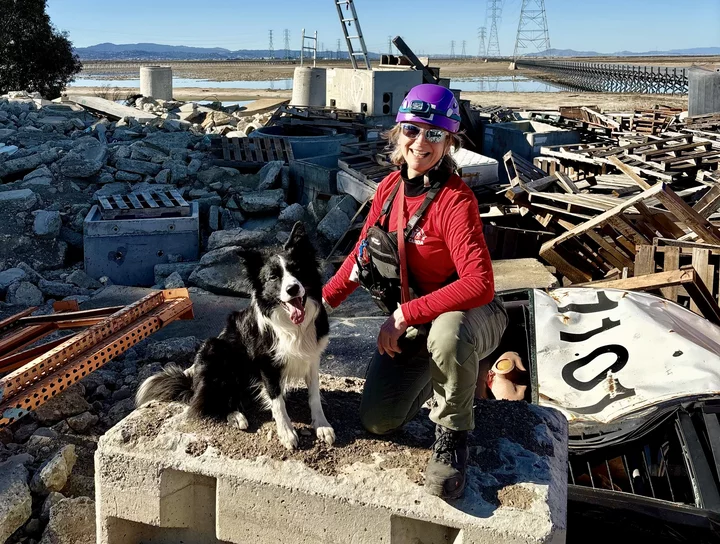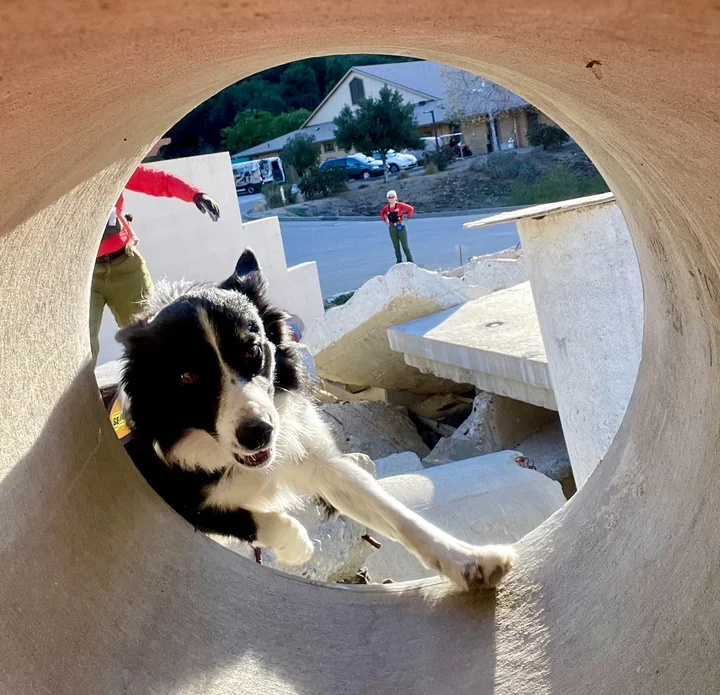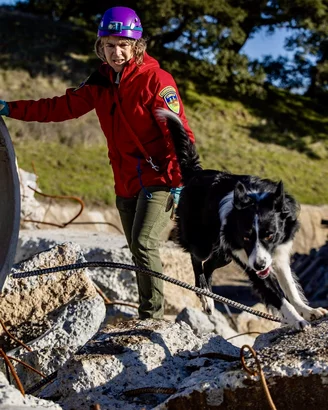Maya Conrad and her search and rescue dog Rowdy, post-certification test, at the Menlo Park, Fire Protection Rescue Training Site. | Photo provided by Maya Conrad.
###
Maya Conrad was following her search and rescue dog, Rowdy, across an expanse of rubble, searching for anyone who might be hidden among the wood pallets, slabs of broken concrete and exposed rebar. Rowdy, a four-year-old border collie, was all laser focus and quick movements, his tail wagging and tongue lolling as he scampered across the disaster zone.
Following his nose, he hopped through an access panel in the roof of an overturned bus. As Conrad followed him, stooping to squeeze through the hole and into the darkness, she couldn’t help but laugh, thinking to herself, “I really didn’t picture myself doing this for a good time, you know. Ever. And here we are.”
Of course, she and Rowdy weren’t really doing this for a good time — or not only for the good time. It was a training run in preparation for a rigorous and highly complex test that Rowdy and Conrad would pass in the coming days, the first team ever to do so, earning them the only “Type 4 Disaster Mission-Ready” certification ever issued by the California Rescue Dog Association (CARDA).
As the organization explained in a congratulatory Facebook post last week, “This rigorous certification demonstrates their ability to support critical search operations following disasters like earthquakes and fires, working alongside local and state response teams to locate survivors.”
Conrad, a local real estate agent whose canine search and rescue work is entirely volunteer, said scouring urban disaster scenes with rubble piles, vehicles and simulated collapsed freeways is not Rowdy’s primary specialty. He’s a certified live-find wilderness area dog, trained to locate people (or human remains) in vast rural landscapes like we have here in Humboldt County.
Rowdy hops into a cement pipe as Maya looks on at the National Disaster Search Dog training center in Santa Paula, Calif.
###
But about a year and a half ago, she and Rowdy were invited to attend a training put on by the National Disaster Search Dog Foundation in Ventura County, where they’ve built a “disaster city” that simulates an urban environment post-massive earthquake, complete with tilted and collapsed buildings.
“And I noticed that, relative to some of the other dogs in our training group, he just thrived searching in that kind of environment,” Conrad said.
Rowdy came to Conrad via a breeder in Grants Pass who said that he’s the first in his a 40-year lineage to do such work.
“I told her that I was interested in doing search and rescue, but I am also a big believer in letting the dog tell you what they what they like and then following suit,” Conrad said.
Last year, she and Rowdy attended a training in the Bay Area hosted by the nonprofit HD Search Dog Fund, whose founder, Tim Houweling is a fellow member of CARDA and a big believer in cross-training dogs so they’re capable of responding to different types of disasters.
“When we’ve had events like the [2018] Paradise fire, there has been such a shortage of canine dogs who are appropriately trained to respond to such a disaster,” Conrad said. “And as we’re seeing with the L.A. conflagrations, there’s going to be more and more of a need for dogs who can do this kind of work.”
Houweling, fire captain and canine search specialist with the Mountain View Fire Department, said he personally designed CARDA’s Type 4 disaster certification test in 2013. He based it on a test from the Federal Emergency Management Agency (FEMA) that’s considered the national standard for search and rescue dogs, though his own test is designed to be attainable by wilderness dogs.
It includes multiple components, including a “robust agility requirement,” an “adjustment and control” portion (ensuring that the dog responds to its trainer’s instructions) and, of course, a search component that requires the dog to locate two people hidden in the rubble. All of these components must be satisfied within a limited time period.
Houweling designed the test with the thought that he and his own search and rescue dogs would be the first to complete the test, but after more than a dozen years, nobody had done so.
“We haven’t had any teams that went out and achieved certification, so Maya and Rowdy were the first ones to do it,” he said. He noted that other types of certification, like those for wilderness search and rescue, allow dogs to pass each component separately, often on days that are weeks or months apart.
“In this test, it’s all in one day, so it’s a pretty big success for Maya to do that,” Houweling said. “She should be pretty proud of herself.”
Maya and Rowdy solve a complicated problem in a simulated disaster-scene course two days before taking their Type 4 certification test.
###
Before getting involved in canine search and rescue training, Conrad trained her dogs — mostly Belgian Malinois — in competitive sports activities such as dock diving for max distance and the Mondioring World Championships (a multi-discipline test of a dog’s obedience, agility and protection skills).
“And that’s really led me on a journey that I’m really passionate about, of canine cognition, canine learning theory and how we develop a dog to do amazing things and really enjoy it,” Conrad said. (She started training Rowdy when he was just seven and a half weeks old.) “And I think the inter-species relationship between humans and dogs is endlessly fascinating. When you get a true working dog, it’s magic to see, and if you know how to focus that energy, it’s really incredible to see what they can do.”
Conrad’s mentor in search and rescue training has been Jan Friedrichsen, commander of the Humboldt County Sheriff’s Office’s volunteer Search and Rescue Team, as well as its K9 lead. She has more than two decades of experience as a K9 search and rescue handler. Conrad and Rowdy are part of the team, too, along with Conrad’s other dog, a Malinois named Shadow. Back in September, the team spent more than three days helping numerous agencies search for a missing Eureka woman, who was eventually found safe.
Friedrichsen said that while Conrad and Rowdy could get called to an emergency anywhere in the state, the local community is lucky to have them nearby.
“If there were a disaster here in Humboldt County, we are not gonna get help for days, so to have some dogs with the exposure, to have Maya and Rowdy’s experience, they’re gonna be the first ones out,” Friedrichsen said. “We’ve got the only dog in the state that’s trained [for such emergencies] and isn’t relying on an outside agency [like FEMA].”
Conrad said Rowdy wasn’t the only one who required training. She had some studying of her own to do, learning about structural collapse, hazardous materials and more. She had to learn how to learn how to decontaminate both her dog and herself.
Asked how she feels about the possibility of responding to a grisly disaster, she said her outlook has changed over the years. The vast majority of wilderness search and rescue involves looking for human remains, but when she told people about her efforts they would envision something much different, like what Rowdy can do now. They’d ask Conrad if she and her dogs would show up to collapsed buildings and the like.
“And my response would always be, ‘Oh, heck no, we’re not doing disasters. I don’t want to do anything like, you know, the World Trade Center [and] put my dog in harm’s way, right?’ But then when I saw how he thrived I thought, well, maybe I should pursue this.”
Rowdy will work for a reward, like a toy, she said, but he also gets fulfillment from the work itself. And if that means they get called on a mission that involves the risk of injury, exposure to hazardous materials and proximity to extreme suffering, so be it.
“My dog is a working dog who finds extreme joy and thrives on this work, and I’ve made a commitment to be [of] service. … Knowing the safety protocols helps me stay safe, and it also gives me the training and the ability to help potentially save lives. I guess it gives me the courage to put my dog and me in harm’s way.”
Rowdy learning to climb a ladder.



CLICK TO MANAGE